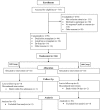Glycemic Control Reduces Infections in Post-Liver Transplant Patients: Results of a Prospective, Randomized Study
- PMID: 27875061
- PMCID: PMC6283442
- DOI: 10.1210/jc.2016-3279
Glycemic Control Reduces Infections in Post-Liver Transplant Patients: Results of a Prospective, Randomized Study
Abstract
Context: Previous studies have shown a relationship between glycemic control and posttransplant morbidity.
Objective: We conducted a prospective randomized controlled trial in postliver transplant patients to evaluate intensive inpatient glycemic control and effects on outcomes to 1 year.
Research design and intervention: A total of 164 patients [blood glucose (BG) >180 mg/dL] were randomized into 2 target groups: 82 with a BG of 140 mg/dL and 82 with a BG of 180 mg/dL. Continuous insulin infusions were initiated and then converted to subcutaneous basal bolus insulin therapy by our glucose management service.
Results: The inpatient mean BG level was significantly different (140 group, 151.4 ± 19.5 mg/dL vs 180 group, 172.6 ± 27.9 mg/dL; P < 0.001). Any infection within 1 year occurred in 35 of the 82 patients (42.7%) in the 140 group and 54 of 82 (65.9%) in the 180 group (P = 0.0046). In a time-to-first infection analysis, being in the 140 group resulted in a hazard ratio of 0.54 (95% confidence interval, 0.35 to 0.83; P = 0.004); the difference between the 2 groups was statistically significant at 1 month (P = 0.008). The number with adjudicated transplant rejection was similar between the 2 groups [17 of 82 (20.7%) and 20 of 82 (24.3%) in the 140 and 180 groups, respectively; P = not significant]. Severe hypoglycemia (BG ≤40 mg/dL) occurred in 3 patients (2 in the 140 group and 1 in the 180 group). However, more patients had moderate hypoglycemia (BG, 41 to 70 mg/dL) in the 140 group [27 of 82 (32.9%) vs 10 of 82 (12.2%) in the 180 group; P = 0.003]. Insulin-related hypoglycemia was not associated with the incidence of severe adverse outcomes.
Conclusions: Glycemic control of 140 mg/dL safely resulted in a reduced incidence of infection after transplantation compared with 180 mg/dL, but with an increase in moderate hypoglycemia.
Copyright © 2017 by the Endocrine Society
Figures


References
-
- Umpierrez GE, Isaacs SD, Bazargan N, You X, Thaler LM, Kitabchi AE. Hyperglycemia: an independent marker of in-hospital mortality in patients with undiagnosed diabetes. J Clin Endocrinol Metab. 2002;87(3):978–982. - PubMed
-
- Capes SE, Hunt D, Malmberg K, Pathak P, Gerstein HC. Stress hyperglycemia and prognosis of stroke in nondiabetic and diabetic patients: a systematic overview. Stroke. 2001;32(10):2426–2432. - PubMed
-
- Finney SJ, Zekveld C, Elia A, Evans TW. Glucose control and mortality in critically ill patients. JAMA. 2003;290(15):2041–2047. - PubMed
-
- McAlister FA, Majumdar SR, Blitz S, Rowe BH, Romney J, Marrie TJ. The relation between hyperglycemia and outcomes in 2,471 patients admitted to the hospital with community-acquired pneumonia. Diabetes Care. 2005;28(4):810–815. - PubMed
-
- Meier JJ, Deifuss S, Klamann A, Launhardt V, Schmiegel WH, Nauck MA. Plasma glucose at hospital admission and previous metabolic control determine myocardial infarct size and survival in patients with and without type 2 diabetes: the Langendreer Myocardial Infarction and Blood Glucose in Diabetic Patients Assessment (LAMBDA). Diabetes Care. 2005;28(10):2551–2553. - PubMed
Publication types
MeSH terms
Substances
Grants and funding
LinkOut - more resources
Full Text Sources
Other Literature Sources
Medical

